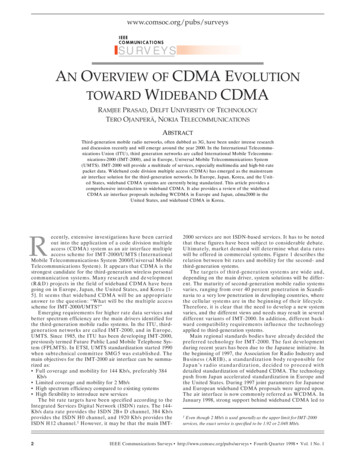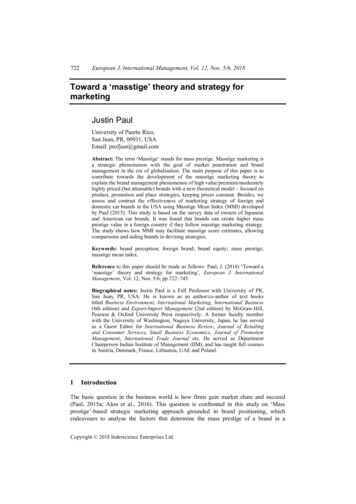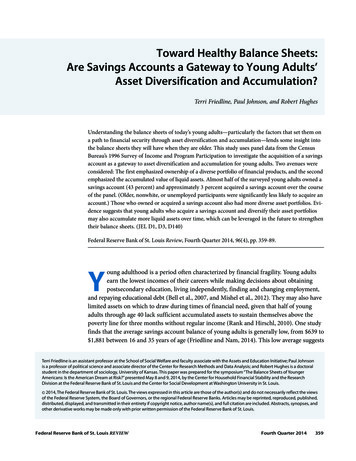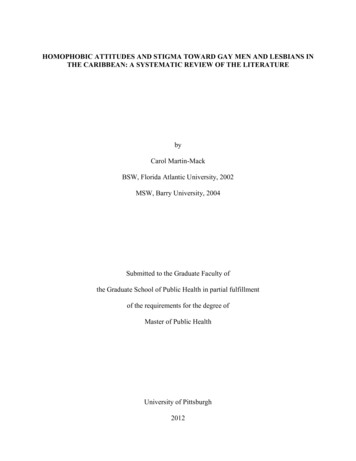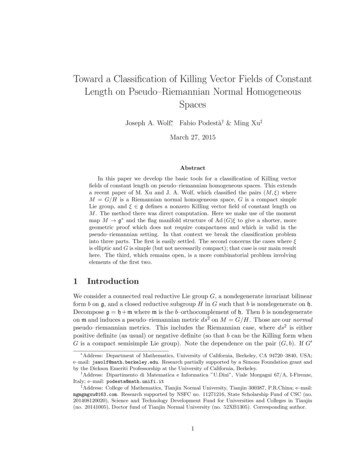
Transcription
Toward a Classification of Killing Vector Fields of ConstantLength on Pseudo–Riemannian Normal HomogeneousSpacesJoseph A. Wolf , Fabio Podestà† & Ming Xu‡March 27, 2015AbstractIn this paper we develop the basic tools for a classification of Killing vectorfields of constant length on pseudo–riemannian homogeneous spaces. This extendsa recent paper of M. Xu and J. A. Wolf, which classified the pairs (M, ξ) whereM G/H is a Riemannian normal homogeneous space, G is a compact simpleLie group, and ξ g defines a nonzero Killing vector field of constant length onM . The method there was direct computation. Here we make use of the momentmap M g and the flag manifold structure of Ad (G)ξ to give a shorter, moregeometric proof which does not require compactness and which is valid in thepseudo–riemannian setting. In that context we break the classification probleminto three parts. The first is easily settled. The second concerns the cases where ξis elliptic and G is simple (but not necessarily compact); that case is our main resulthere. The third, which remains open, is a more combinatorial problem involvingelements of the first two.1IntroductionWe consider a connected real reductive Lie group G, a nondegenerate invariant bilinearform b on g, and a closed reductive subgroup H in G such that b is nondegenerate on h.Decompose g h m where m is the b–orthocomplement of h. Then b is nondegenerateon m and induces a pseudo–riemannian metric ds2 on M G/H. Those are our normalpseudo–riemannian metrics. This includes the Riemannian case, where ds2 is eitherpositive definite (as usual) or negative definite (so that b can be the Killing form whenG is a compact semisimple Lie group). Note the dependence on the pair (G, b). If G0 Address: Department of Mathematics, University of California, Berkeley, CA 94720–3840, USA;e–mail: jawolf@math.berkeley.edu. Research partially supported by a Simons Foundation grant andby the Dickson Emeriti Professorship at the University of California, Berkeley.†Address: Dipartimento di Matematica e Informatica ”U.Dini”, Viale Morgagni 67/A, I-Firenze,Italy; e–mail: podesta@math.unifi.it‡Address: College of Mathematics, Tianjin Normal University, Tianjin 300387, P.R.China; e–mail:mgmgmgxu@163.com. Research supported by NSFC no. 11271216, State Scholarship Fund of CSC (no.201408120020), Science and Technology Development Fund for Universities and Colleges in Tianjin(no. 20141005), Doctor fund of Tianjin Normal University (no. 52XB1305). Corresponding author.1
is another transitive group of isometries of (M, ds2 ) then ds2 need not be normal as ahomogeneous space of G0 .Let ξ g. It induces a Killing vector field on M which we denote ξ M . If x Mthen ξxM is the corresponding tangent vector at x. We say that ξ M has constant length(perhaps pseudo–length would be a better term) if the function x 7 ds2 (ξxM , ξxM ) isconstant on M . The goal of this paper is the classification of triples (G, H, ξ) whereξ g is nonzero and elliptic, and where ξ M has constant length.In the setting of pseudo–riemannian manifolds, constant length Killing vector fields(also called Clifford–Killing or CK vector fields; see [11]) are the appropriate replacement for isometries of constant displacement (CW isometries).In Section 2 we discuss a flag manifold GC /Q that connects the moment map forconjugation orbits in g with the length function for ξ M . Then in Section 3 we developa method of passage through the complex domain that carries this connection to flagdomains and the pseudo–riemannian setting. In Section 4 we use these tools to carryout the classification for the cases where GC is simple; the main result is Theorem4.3. Those tools don’t apply directly to the case where G is simple but GC is not,but in Section 5 we use other methods to carry out the classification; there the mainresult is Theorem 5.2. Section 6 summarizes these classifications to give one of thetwo main results of this paper, Theorem 6.1. As a consequence of these classifications,Corollary 6.2 indicates the pseudo–riemannian analog of the correspondence betweenhomogeneity for quotient manifolds and isometries of constant displacement.The other principal result is Theorem 7.6, which in effect describes current progresstoward a classification where G need not be simple.Let prh and prm denote the respective orthogonal projections of g to h and m. Then2ds (ξxM , ξxM ) b(prm (Ad (g)ξ), prm (Ad (g)ξ)) where x gH. Since b(Ad (g)ξ, Ad (g)ξ)is independent of g G, andb(Ad (g)ξ, Ad (g)ξ) b(prh (Ad (g)ξ), prh (Ad (g)ξ)) b(prm (Ad (g)ξ), prm (Ad (g)ξ)),Lemma 1.1. Let ξ g. Then ξ M has constant length if and only iffξ (g) : b(prh (Ad (g)ξ), prh (Ad (g)ξ))is independent of g G.In view of Lemma 1.1 and our assumption that G is connected, the constant lengthproperty for ξ M depends only on the pair (g, h). Thus we can (and will) be casual aboutpassing to and from covering groups of G and about connectivity of H. In practise thiswill be only a matter of whether it is more convenient to write Spin or SO.2The Flag DomainWe use b to identify adjoint orbits of G on g and coadjoint orbits of G on g .Proposition 2.1. Suppose that ξ g is elliptic, in other words that ad (ξ) is semisimple(diagonalizable over C) with pure imaginary eigenvalues. Let L denote the centralizerof ξ in G. Then GC has a parabolic subgroup Q with the properties2
L is the isotropy subgroup of G at the base point z0 1Q for the action of G (asa subgroup of GC ) on the complex flag manifold Z GC /Q, LC is the reductive part of Q, the orbit G(z0 ) Z is open and carries a G–invariant pseudo–Kähler metric,which can be normalized so that Ad (g)ξ 7 gQ is a symplectomorphism of Oξ : Ad (G)ξ onto G(z0 ) where thesymplectic form on Oξ is the Kostant–Souriau form ω(η, ζ) b(ξ, [η, ζ]) and thesymplectic form on G(z0 ) is the imaginary part of the invariant pseudo–Kählermetric.In particular Oξ has a G–invariant pseudo–Kähler structure.Proof. By construction L is reductive. In fact ξ is contained in a fundamental (maximally compact) Cartan subalgebra t of g, andP lC is tC plus all the tC –root spaces gαfor roots α that vanish on ξ. Define q lC α(iξ) 0 gα . It is a parabolic subalgebraof gC with reductive part lC .Let τ denote complex conjugation of gC over g. Then τ (iξ) iξ so q τ q gC ,and also q τ q lC . There are two immediate consequences: (i) G(z0 ) is open inZ GC /Q and (ii) Ad (g)ξ 7 gQ is a diffeomorphism of Oξ onto G(z0 ). Note that (ii)uses simple connectivity of both Z and Oξ .Since q τ q lC , which is reductive, G(z0 ) carries a G–invariant measure. Anysuch measure comes from the volume form of an invariant indefinite–Kähler metric; see[9], or see the exposition of flag domains in [2], This metric is constructed in [9] usingan invariant bilinear form; as is the Kostant–Souriau form, and by the construction aproper normalization of the metric has imaginary part equal to the Kostant–Souriauform.Remark 2.2. In our flag domain cases, Proposition 2.1 extends the structural resultof [1, Theorem 1.3(4)] from symplectic to pseudo–Kähler. Remark 2.3. The parabolic q is the sum of the non-positive eigenspaces of ad (iξ) ongC . If g GC now Ad (g)q is the sum of the non-positive eigenspaces of ad (Ad (g)ξ)on gC . As Q is its own normalizer in GC we can identify Z GC /Q with the spaceof Ad (GC )–conjugates of q. Thus, if S is any subgroup of GC , we see exactly howAd (S)ξ Z. We are using b to identify g with g ; similarly use b h to identify h with h . Theinclusion(2.4)µG : Oξ , gcoincides with the moment map for the (necessarily Hamiltonian) action of G on Oξ .Now consider the action of H on Oξ . The corresponding moment map is(2.5)µH : prh µG : Oξ h.Thus Lemma 1.1 can be reformulated asLemma 2.6. Let ξ g. Then ξ M has constant length if and only ifζ 7 b(µH (ζ), µH (ζ)) is constant on Oξ .3
3Holomorphic ConsiderationsThe group H is reductive in G because b is nondegenerate on h. Thus [4] there is aCartan involution θ of G such that θ H is a Cartan involution on H. That gives us thedecompositionsg k p and h (h k) (h p)into 1 eigenspaces of dθ.From now on we suppose that G is semisimple and that b is a positive linear combination of the Killing forms of the simple ideals of g. Thus b is negative definite on kand positive definite on p. {The reader can extend many of our results to the case ofreductive G by stipulating b(k, p) 0, b negative definite on k, and b positive definiteon p.} The decompositions of g and h give us compact real formsgu k ip hu mu where hu (h k) i(h p) and mu (m k) i(m p)of gC hC and mC . Let Gu and Hu denote the compact real forms of GC and HCcorresponding to gu and hu .Extend b to a C–bilinear form bC on gC . Then bu : bC gu is negative definite. Asb(h, m) 0 we have bC (hC , mC ) 0 and thus bu (hu , mu ) 0. The orthogonal projectionprhC : gC hC restricts to orthogonal projection prhu : gu hu .Lemma 3.1. Define fξ : GC C by fξ (g) b(prhC (Ad (g)ξ), prhC (Ad (g)ξ)). Then fξis holomorphic.Proof. The map g 7 Ad (g)ξ is holomorphic on GC , the projection prhC : gC hC isholomorphic, and b is complex bilinear.Lemma 3.2. If ξ M has constant length then fξ : GC C is constant, and in particularfξ Gu is constant.Proof. If ξ M has constant length then fξ is constant on G. Since G is a real form ofGC and fξ is holomorphic, it follows that fξ is constant.Denote Mu Gu /Hu where Mu carries the normal homogeneous Riemannian metricdefined by bu mu . In effect it is the natural compact real form of the affine algebraicvariety MC GC /HC dual to M G/H. If ξ k, in particular if ξ gu , we write ξ Mufor the corresponding vector field on Mu . Now Lemmas 2.6 and 3.2 give usProposition 3.3. If ξ k and ξ M has constant length on M if, and only if, ξ Mu hasconstant length on the Riemannian normal homogeneous space Mu : Gu /Hu .4Classification for GC SimpleIn this section we carry out the classification of constant length Killing vector fieldsξ M , on reductive normal homogeneous pseudo–riemannian manifolds M G/H whenthe group GC is simple. The compact version of this classification was done by directcomputation in [11], but here we have a less computational approach that starts with4
classification ([5], or see [6]) of Onischik for irreducible complex flag manifolds Z Gu /Lu , on which a proper closed subgroup Hu of Gu acts transitively. On the otherhand we need the classification where H need not be compact. For that we use methodsfrom [10]. In Section 5 we give a separate argument to deal with the case where G issimple but GC is not. Then in Section 6 we translate those results to the classificationof constant length Killing vector fields ξ M on reductive normal homogeneous pseudo–riemannian manifolds M G/H, with G simple and ξ nonzero and elliptic.For clarity of exposition we always assume that GC is connected and simply connected, that the real forms G and Gu are analytic subgroups of GC , and that H, HCand Hu are analytic subgroups of G, GC and Gu .Proposition 4.1. [5] Consider a complex flag manifold Z GC /Q. Suppose that Zis irreducible, i.e., that GC is simple. Then the closed connected subgroups Hu Gutransitive on Z, {1} 6 Hu Gu , are precisely those given as follows.1. Z SU (2n)/U (2n 1) P 2n 1 (C), complex projective (2n 1)–space; thereGC SL(2n; C) and Hu Sp(n).2. Z SO(2n 2)/U (n 1), unitary structures on R2n 2 ; there GC SO(2n 2; C)and Hu SO(2n 1).3. Z Spin(7)/(Spin(5) · Spin(2)), nonsingular complex quadric; there GC Spin(7; C) and Hu is the compact exceptional group G2 .Here is the noncompact version of Proposition 4.1.Proposition 4.2. Consider a complex flag manifold Z GC /Q with GC simple. Hereis a complete list of the connected subgroups H G with H 6 {1} and Hu transitiveon Z.1. Z SU (2n)/U (2n 1) P 2n 1 (C) and Hu Sp(n). Then (G, H) is one of(i) (SU (2p, 2q), Sp(p, q)) with p q n or(ii) (SL(2n; R), Sp(n; R)).2. Z SO(2n 2)/U (n 1) and Hu SO(2n 1). Then (G, H) must be(i) (SO(2p 1, 2q 1), SO(2p 1, 2q)) with p q n or(ii) (SO(2p 2, 2q), SO(2p 1, 2q)) with p q n.3. Z Spin(7)/(Spin(5) · Spin(2)) and Hu G2 . Then the pair (G, H) must be(i) (Spin(7), G2 ) or(ii) (Spin(3, 4), (G2 )R ). (Here (G2 )R is the split real form of (G2 )C ).Proof. Suppose Z SU (2n)/U (2n 1; C) P 2n 1 (C) and Hu Sp(n). The realforms of (Hu )C Sp(n; C) are the Sp(p, q), p q n, and Sp(n; R), and the realforms of (Gu )C SL(2n; C) are the SU (r, s), r s 2n and the special linear groupsSL(2n; R) and SL(n; H). If G SU (r, s) and J I0r I0 s then G {g SL(2n; C) g · J · t ḡ J}. ThusH 6 Sp(n; R), for that group cannot have both a symmetric and an antisymmetricbilinear invariant on R2n . Now G SU (r, s) implies H Sp(p, q), which in turnimplies G SU (2p, 2q). Also, if G SL(2n; R) then H 6 Sp(p, q) so H Sp(n; R). Next suppose Z SO(2n 2)/U (n 1) and Hu SO(2n 1). The real formsof (Hu )C SO(2n 1; C) are the SO(r, s) with r s 2n 1, and the real forms of5
(Gu )C SO(2n 2; C) are the SO(k, ) with k 2n 2 and SO (2n 2). Themaximal compact subgroup of SO (2n 2) is U (n 1), which does not contain anySO(r) SO(s) with r s 2n 1; so G 6 SO (2n 2). Thus G SO(k, ) andH SO(r, s) with r 5 k, s 5 and k r s 1, as asserted.Finally suppose Z Spin(7)/(Spin(5) · Spin(2)) and Hu G2 . The real forms of(Gu )C Spin(7; C) are the Spin(a, b) with a b 7, and the real forms of (Hu )C (G2 )C are the compact form G2 and the split form (G2 )R . Now [8, Theorem 3.1]completes the argument that G/H is Spin(7)/G2 or Spin(3, 4)/(G2 )R .Now we summarize, include the case where Hu acts trivially on Z, and note thatone case is eliminated by the requirement that ξ g.Theorem 4.3. Suppose that G is absolutely simple, i.e. that GC is simple. Then thereis a nonzero elliptic element ξ g such that the Killing vector field ξ M on the normalhomogeneous space M G/H has constant length, if and only if, up to finite covering,(G, H) is one of the following pairs.1. Z SU (2n)/U (2n 1) P 2n 1 (C) and Hu Sp(n). Then (G, H) is one of the(SU (2p, 2q), Sp(p, q)) with p q n, or is (SL(2n; R), Sp(n; R)).2. Z SO(2n)/U (n) and Hu SO(2n 1). Then (G, H) is one of the(SO(2p, 2q), SO(2p 1, 2q)) with p q n.3. Z Spin(7)/(Spin(5) · Spin(2)) and Hu G2 . Then (G, H) is(Spin(7), G2 ) or (Spin(3, 4), (G2 )R ).4. h 0 and (G, H) is the group manifold pair (G, {1}).Proof. Retain the notation of Section 3. We can suppose ξ k gu . By Proposition3.3, ξ induces a Killing vector field ξ Mu of constant length on the normal homogeneousRiemannian manifold Mu Gu /Hu . The adjoint orbit Z : Ad (Gu )ξ gu is endowedwith the Gu –invariant symplectic structure given by the Kostant–Souriau form. Theb–orthogonal projection prh : Z hu defines a moment map µ for the Hamiltonianaction of Hu on Z. By hypothesis µ has constant length with respect to b hu , and by[3] the flag manifold Z is a Kähler product Z1 Z2 with Hu acting transitively on Z1and trivially on Z2 . Since GC is simple, either Z Z1 or Z Z2 . , and if Hu is nottrivial then Hu acts transitively on Z. We have shown that (G, H) either is a groupmanifold or is one of the pairs listed in Propositions 4.1 and 4.2.In the cases listed in Proposition 4.1, i.e. the cases where G is compact, we alreadyhave nonzero elliptic elements ξ g such that the centralizer of ξ in G is transitiveon G/H. For G/H SU (2n)/Sp(n) we use ξ1 1 diag { (2n 1), I2n 1 }; it hascentralizer U (2n 1) in G. For G/H SO(2n)/SO(2n 1) we use ξ2 diag {J, . . . , J}01where J 1 0 ; it has centralizer U (n) in G. For G/H Spin(7)/G2 we considerspin(5) spin(2) g and take 0 6 ξ3 spin(2).Now consider the noncompact cases listed in Proposition 4.2. Going case by case,g contains an appropriate multiple of the ξi gu of the previous paragraph, with thesingle exception of the spaces SO(2p 1, 2q 1)/SO(2p 1, 2q). That completes theproof of Theorem 4.3.6
Remark 4.4. In the case (G, H) (G, {1}), M is the group manifold, the metric isany nonzero multiple of the Killing form, G acts on itself by left translation, and ξ canbe any element of g because it is centralized by all right translations. In this case ξ Mis of constant length without the requirement that ξ be elliptic. 5Classification for G complex simpleWe now look at the case where G is simple but GC is not. That is when G is theunderlying real structure of a complex simple Lie group E; then GC E E where Eis the complex conjugate of E and G , GC is the diagonal δE , GC . It is convenientto use the following very general lemma, which is based on the infinitesimal version of[7, Théorème 1].Lemma 5.1. Let (M, ds2 ) be any connected pseudo–riemannian homogeneous space.Let ξ g. If the centralizer L : {g I(M, ds2 ) Ad (g)ξ ξ} of ξ in the isometry group I(M, ds2 ) has an open orbit on M then ξ M has constant length on M . Inparticular if L is transitive on M then ξ M has constant length on M .Proof. Let O be an open L–orbit on M . If x, y O, say gx y with g L, thends2 (ξyM , ξyM ) ds2 (dg(ξxM ), dg(ξxM )) ds2 (ξxM , ξxM ). Thus ξ M 2 is constant on O. As ξ M 2 is real analytic on M it is constant.Theorem 5.2. Suppose that G is simple but GC is not. Then there is a nonzeroelliptic element ξ g such that the Killing vector field ξ M on the normal homogeneous space M G/H has constant length, if and only if, up to finite covering,(G, H) is one of the pairs (1) (SL(2n; C), Sp(n; C)), (2) (SO(2n; C), SO(2n 1; C)),(3) (Spin(7; C), (G2 )C ), or (4) the group manifold pair (G, {1}).Remark 5.3. In all cases of Theorem 5.2, G/H is a complex affine algebraic variety.Also, in the case (G, H) (G, {1}), M is the group manifold, the metric is any nonzeromultiple of the Killing form, G acts on itself by left translation, and ξ can be any elementof g because it is centralized by all right translations. In this case ξ M is of constantlength without the requirement that ξ be elliptic. Proof. Let ξ g be nonzero and elliptic. We may assume that it is contained in the Liealgebra k of a maximal compact subgroup K of G. The point is that it is contained in afundamental (maximally compact) Cartan subalgebra of g. All such Cartan subalgebrasare Ad (G)–conjugate, and the g–centralizer of any Cartan subalgebra of k is one ofthem. Thus, for the proof, we may assume ξ k.Note that K is a compact real form when G is regarded as a complex simple group.Passing to a conjugate, H is stable under the complex conjugation τ of G with fixedpoint set K, for τ is a Cartan involution. Now g k ik under τ and h h k h ik.These are orthogonal decompositions relative to the Killing form of G, and the invariantbilinear form b is a positive multiple of that Killing form.Suppose that ξ M has constant length, equivalently that b(prh (Ad(g)ξ)), prh (Ad(g)ξ)))is constant for g G. Then b(prh k (Ad(g)ξ), prh k (Ad(g)ξ)) is constant for g K. Inother words ξ defines a constant length Killing vector field on K/(K H).7
If k h k then k h. The adjoint action of k on g is the sum of two copies ofthe adjoint representation of k, which is irreducible, so k h says that either h k orh g. If h k there is no nonzero Killing vector field of constant length on G/H. Ifh g then G/H is reduced to a point. So k h 6 k.If k h 0 then b(k, h) 0 so ξ k m. Then prm (ξ) ξ and prh (ξ) 0. Inparticular b(prm (Ad (g)ξ), prm (Ad (g)ξ)) b(ξ, ξ) and b(prh (Ad (g)ξ), prh (Ad (g)ξ)) 0for all g G. Now Ad (G)ξ m, so m contains a nonzero ideal of the simple Lie algebrag. In other words m g and h 0, so M is the group manifold G.Now suppose k h 6 0. As k h k and ξ defines a constant length Killing v
Lis the isotropy subgroup of Gat the base point z 0 1Qfor the action of G(as a subgroup of G C) on the complex ag manifold Z G C Q, L C is the reductive part of Q, the orbit G(z 0) ˆZ is open and carries a G{invariant

